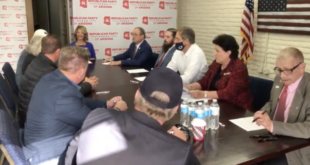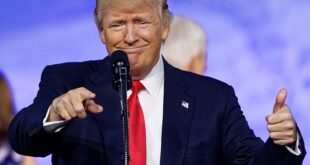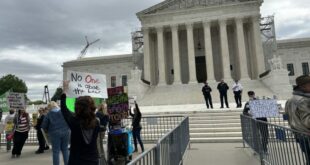Jacob Fischler, Washington State Standard
The federal indictment accusing Donald Trump of trying to stay in power after losing the 2020 presidential election includes detailed accusations of Trump and his alleged co-conspirators’ pressure on individual state officials.
The central plot to overturn the election, as described in the indictment a federal grand jury in Washington, D.C., handed up Tuesday, involved switching out legitimate slates of electors in multiple states Joe Biden had won with false electors recruited by Trump and his advisers.
The sweeping indictment also accuses Trump and six co-conspirators of using the U.S. Justice Department to falsely insinuate that there were legitimate concerns with the elections in each state and presenting dueling slates of electors to Vice President Mike Pence to create a false controversy about which electors to count.
But those parts of the scheme depended on first creating the slates of fake electors and having state officials grant them legitimacy, according to the indictment.
To gather those fraudulent electors, Trump and his close allies pressured, threatened and lied to state lawmakers and elections officials in Arizona, Georgia, Michigan, Nevada, New Mexico, Pennsylvania and Wisconsin, according to the indictment.
Trump “and his co-conspirators executed a strategy to use knowing deceit in the targeted states to impair, obstruct, and defeat the federal government function,” the indictment reads.
The scheme grew out of a legal challenge related to the election results in Wisconsin, according to the indictment.
With a recount in the state possible, an attorney identified only as “Co-Conspirator 5” in mid-November proposed gathering slates of alternate electors in the event Trump ultimately won the state. The indictment does not identify alleged co-conspirators by name or initials.
But less than three weeks later, the attorney wrote a new memo that was “a sharp departure” from the lawful strategy in Wisconsin.
The later memo advocated an illegal scheme to have fraudulent electors in key states mirror legitimate electors’ certification process, according to the indictment. The dual slates of electors could then cast doubt on the legitimacy of Biden’s electors, according to the indictment.
“The memoranda evolved over time from a legal strategy to preserve the Defendant’s rights to a corrupt plan to subvert the federal government function by stopping Biden electors’ votes from being counted and certified,” the indictment said.
Trump’s aim in each state was the same. The campaigns to recruit false electors in each differed, according to the indictment.
Arizona
Trump’s allies pressured the Republican speaker of the House, Rusty Bowers, to have the Legislature reject the legitimate election results, according to the indictment.
An attorney identified in the indictment as “Co-Conspirator 1” reached out to Bowers after the 2020 election with claims that non-citizens, non-residents and dead people had voted in the state. Trump and the co-conspirator, whose actions match those Bowers attributed to Trump attorney Rudy Giuliani, knew the claims were false, according to the indictment.
Much of Special Counsel Jack Smith’s information on the Arizona scheme overlaps with testimony Bowers gave at a June 2022 hearing of the U.S. House committee that investigated Trump’s role in the Jan. 6, 2021, attack.
At that hearing, Bowers said that when Bowers asked Giuliani for evidence of fraud, Giuliani responded that the Trump team didn’t have evidence, but had “lots of theories.” That quote is attributed in the indictment to “Co-Conspirator 1.”
Bowers, a self-described conservative who voted and campaigned for Trump, refused to cooperate with the effort to overturn Arizona’s election results, saying in a public statement that it would have violated his oath of office.
Another Trump attorney, identified as “Co-Conspirator 5,” contacted him on Jan. 4, 2021, after the state’s electors had been certified, to “urge” Bowers to decertify those electors, the indictment reads. Bowers again refused.
Trump and his team still organized a group of false electors, including then-state party Chairwoman Kelli Ward, but it lacked the backing of the state’s Legislature that Trump had sought, according to the indictment.
Georgia
Trump and his team appealed to Georgia Republicans on two main fronts.
They promoted a video that purported to show suitcases full of illegal ballots being dumped in Atlanta. “Co-Conspirator 1” gave a presentation to a subcommittee of the majority-Republican Georgia Senate that included a video of purported “ballot dumping” at State Farm Arena in the heavily Democratic city. The purpose of the presentation was to mislead lawmakers, according to the indictment.
Giuliani made that presentation, according to testimony to the U.S. House committee.
State elections officials later said the video showed “normal ballot processing.”
Regardless, as a last-ditch effort, Trump personally phoned Secretary of State Brad Raffensperger, an elected Republican, on Dec. 10. A recording of that call, which has been previously reported, showed Trump asking the state’s chief elections official to “find” nearly 12,000 votes — enough to reverse the election results.
In the call with Raffensperger, Trump said the true election results were tainted by fraud, saying dead people had voted and again raising the video from State Farm Arena. He implied Raffensperger would face criminal prosecution if he didn’t do as the president demanded.
Raffensperger also recounted his experience at a U.S. House committee hearing.
Another co-conspirator, another attorney identified as “Co-Conspirator 3,” raised the possibility that voting machines had been used in “massive voter fraud,” according to the indictment. “Co-Conspirator 3” filed a lawsuit against Gov. Brian Kemp, a Republican, that claimed voting machines were used to accomplish election fraud, the indictment reads.
Michigan
In December 2020, Trump hosted Michigan’s legislative leaders, Senate Majority Leader Mike Shirkey and House Speaker Lee Chatfield, both Republicans, at the Oval Office.
During that meeting, he raised a series of false claims of election fraud in the state, according to the indictment. Shirkey responded that Trump had lost not because of fraud, but because he underperformed with certain groups of voters.
After they left the meeting, the lawmakers released a joint statement that they would review the election process, but that they had “not yet been made aware of any information that would change the outcome of the election in Michigan.”
Shirkey and Chatfield later received messages from “Co-Conspirator 1” and another attorney identified as “Co-Conspirator 2” asking for them to use their positions to cast doubt on the election results, the indictment said.
“I need you to pass a joint resolution,” “Co-Conspirator 1” wrote in a text message intended for Shirkey, according to the indictment.
The resolution should say that the election is in dispute because of an investigation of fraud and that the electors sent by the state’s Democratic Gov. Gretchen Whitmer are not official, “Co-Conspirator 1” said, according to the indictment.
Shirkey and Chatfield proceeded with certifying Biden’s win in the state on Dec. 14, saying they still had no evidence to suggest Biden’s win was illegitimate.
The indictment did not include other details of efforts to overturn Michigan’s election results, such as Giuliani’s appearance at a December 2020 state House hearing where he urged members to “take back (their) power” by rejecting the election results.
Nevada
Nevada’s secretary of state refuted claims from Trump that the state received “tens of thousands of double votes” and experienced other voter fraud, according to the indictment.
In a public document, titled “Fact vs. Myths,” the secretary of state detailed that “Nevada judges had reviewed and rejected them, and the Nevada Supreme Court had rendered a decision denying such claims.”
The indictment notes that after Trump met with “repeated failure” in obstructing the vote through deceiving state officials, he and co-conspirators decided to establish slates of fake electors in seven states, including Nevada.
“Under the plan, the submission of these fraudulent slates would create a fake controversy at the certification proceeding and position the Vice President — presiding on January 6 as President of the Senate — to supplant legitimate electors with the Defendant’s fake electors and certify the Defendant as president,” according to the indictment.
An unnamed co-conspirator in the case, identified in the indictment only as “Co-Conspirator 5,” wrote a memo on Dec. 6 titled “Fraudulent Elector Memo” and one on Dec. 9 titled “Fraudulent Elector Instructions.” Both named Nevada as a “contested” state.
On Dec. 7, two unnamed people identified as “Co-Conspirator 1” and “Co-Conspirator 6” spoke about lawyers “who could assist in the fraudulent elector effort in the targeted states,” according to the indictment.
New Mexico
The indictment says the plan for fake electors began in “early December” in several states, “even New Mexico, which the Defendant had lost by more than ten percent of the popular vote.”
“This expansion was forecast by emails the Defendant’s Chief of Staff sent on December 6, forwarding the Wisconsin Memo to Campaign staff and writing, ‘We just need to have someone coordinating the electors for states,’” reads the indictment.
The indictment says that on Dec. 7, an unnamed person called “Co-Conspirator 1” spoke with someone called “Co-Conspirator 6” about finding attorneys who could help with the effort to establish fraudulent electors in several states and lists New Mexico as one of those states.
On Dec. 10, “Co-Conspirator 5” sent contact points to five of the seven states, leaving out Wisconsin, which had already been sent a memo, and New Mexico.
Three days later, on Dec. 13, “Co-Conspirator 5” wrote and sent fraudulent elector certificates for Trump’s false electors in New Mexico, even though the state “had not previously been among the targeted states, and where there was no pending litigation on the Defendant’s behalf,” according to the indictment.
The next day, on Dec. 14, the campaign filed an election challenge lawsuit six minutes before the noon deadline “as a pretext so that there was pending litigation there at the time the fraudulent electors voted,” according to the indictment.
The same day, the state’s legitimate electors met to officially cast their votes for president, with New Mexico’s six electoral votes going to Biden, who won the state by more than 33,500 votes.
Pennsylvania
In the Keystone State, Trump allegedly began working against the legitimate election results on Nov. 11, 2020, when he “publicly maligned” a Philadelphia commissioner for saying on a news program that there was no evidence of widespread voter fraud in the city.
“As a result, the Philadelphia City Commissioner and his family received death threats,” according to the indictment.
On Dec. 4, Trump re-tweeted a post that called Republican state lawmakers cowards after they said publicly the General Assembly didn’t have the “authority to overturn the popular vote and appoint its own slate of electors, and that doing so would violate the state Election Code and Constitution.”
Trump then repeatedly communicated with the acting attorney general and acting deputy attorney general about false allegations that Pennsylvania reported 205,000 more votes than voters.
“Each time, the Justice Department officials informed the Defendant that his claim was false,” according to the indictment.
Trump then publicly repeated that false statement on Jan. 6, 2021.
Wisconsin
The indictment notes that a recount of the vote in Wisconsin, which Trump’s campaign petitioned and paid for, actually increased Biden’s margin of victory.
The state’s Supreme Court rejected a challenge from Trump’s campaign on Dec. 14, 2020, with one justice writing that nothing in the case “casts any legitimate doubt that the people of Wisconsin lawfully chose Vice President Biden and Senator Harris to be the next leaders of our great country.”
Wisconsin’s governor signed a final determination on Dec. 21 confirming that Biden “received the highest number of votes in the state and that his electors were the state’s legitimate electors.”
Later that day, Trump tweeted claims about election fraud in the state that he knew were false and demanded “the Wisconsin legislature overturn the election results that had led to the ascertainment of Biden’s electors as the legitimate electors,” according to the indictment.
Less than a week later, Trump communicated with the acting attorney general and acting deputy attorney general on Dec. 27 about a false claim there were more votes than voters in Wisconsin.
“The Acting Deputy Attorney General informed the Defendant that the claim was false,” according to the indictment.
Trump then publicly repeated the claim, having been told it wasn’t accurate or correct, on Jan. 6, 2021.
Washington State Standard is part of States Newsroom, a nonprofit news network supported by grants and a coalition of donors as a 501c(3) public charity. Washington State Standard maintains editorial independence. Contact Editor Bill Lucia for questions: info@washingtonstatestandard.com. Follow Washington State Standard on Facebook and Twitter.
 Poli Alert Political & Civics
Poli Alert Political & Civics



